Homelessness Crisis
Man with Knife Killed in Confrontation with Kern Deputies
TEHACHAPI, Calif. (AP) – A man with a knife confronted Kern County deputies responding to a domestic disturbance and was fatally shot, the Sheriff’s Office said in a brief statement Friday.
The man died at the scene Thursday evening at a mobile home park in Tehachapi, about 40 miles southeast of Bakersfield, the statement said.
Deputies found a male victim suffering from multiple stab wounds that were not life-threatening, the office said. The victim was taken to a local hospital for treatment.
Homicide detectives responded and took over the investigation.
California Man Gets Life for Murder of Teen He Met Online
BAKERSFIELD, Calif. (AP) – A Southern California man was sentenced to life in prison without the possibility of parole after admitting that he raped and killed a 13-year-old girl he met online, then set her body on fire.
Armando Cruz, of Inglewood, accepted an agreement to plead guilty to murder, rape, kidnapping and other charges in exchange for a life sentence, KBAK-TV reported Tuesday.
Cruz met Patricia Alatorre of Bakersfield on social media in 2020 and the pair exchanged photos and later met up, Kern County prosecutors said.
California state and local officials are serious about tackling the state’s growing homelessness crisis head on as it continues to rise.
Last month, Gov. Gavin Newsom signed legislation related to solving this issue.
Over $15.3 billion has been budgeted in housing programs aimed at curtailing California’s homeless.
“State and federal resources have certainly made a difference in our communities,” said Bakersfield’s Mayor Karen K. Goh. “You know, going back to 2020 and 2021 with the Cares Act and then followed by the American Rescue Plan Act (ARPA), the dollars are making their way to our citizens.”
Goh also pointed to Project Homekey as a program that has helped alleviate homelessness.
“Project Homekey resources are being used to transform underutilized motels and hotels, into safe shelter, and in our communities,” said Goh.
The COVID-19 pandemic has played a significant role in the rise of homelessness, from 150,000 in 2019 to 161,000 in 2020, according to the U.S. Department of Housing and Urban Development.

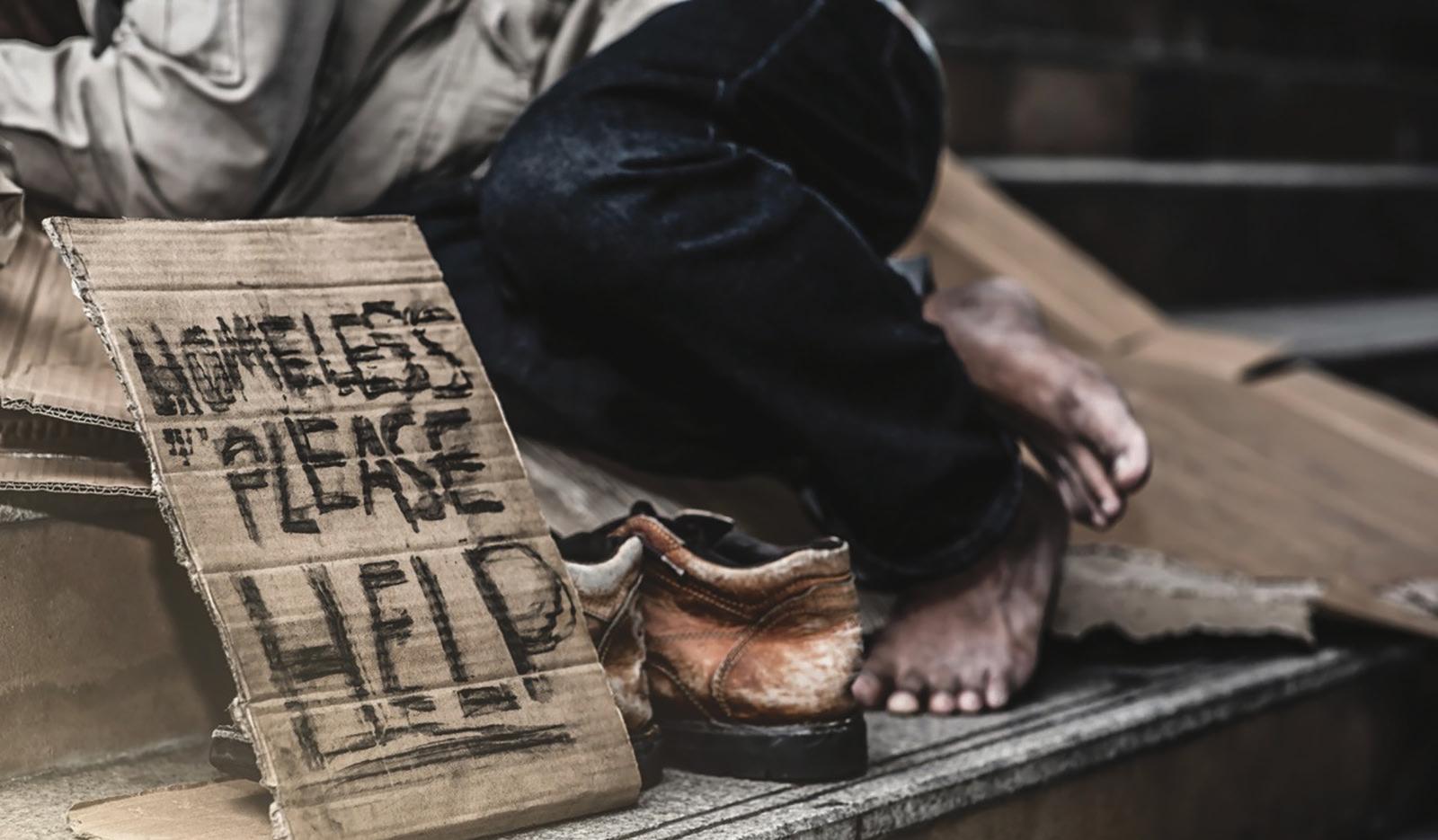
The African American population in California has suffered disproportionately from this phenomenon.
The California Budget and Policy Center reports that Black people are roughly 25% of the state’s homeless although they make up about 5.5 % of California’s population.
Some of the funding the state provided went to the Community Assistance, Recovery and Empowerment
Court — or Care Court, a program that diverts homeless people with severe mental health problems away from the criminal justice system and into mandatory treatment.
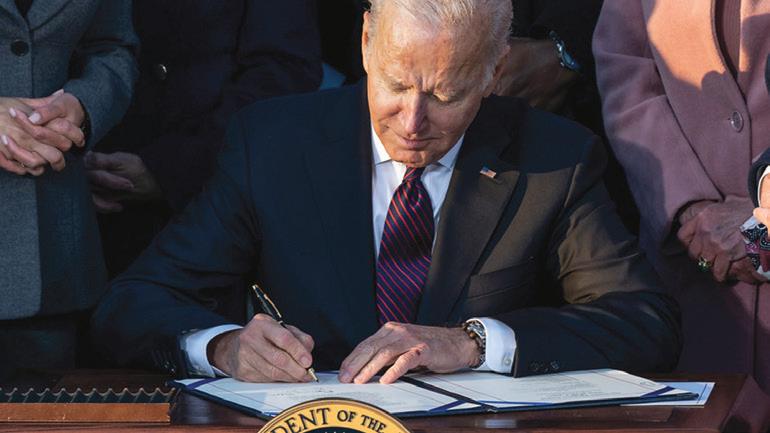
Signed into law on Sept. 14, Senate Bill 1338 (Care Court Act) by Sen. Thomas Umberg (D-Santa Ana) and Sen. Susan Talamantes Eggman (D-Stockton) focuses on untreated individuals suffering from psychotic disorders, such as schizophrenia.
Bills Newsom signed on affordable housing include Senate Bill 561 by State Sen. Bill Dodd (D-Napa), Assembly Bill (AB) 2233 by Assemblymember Sharon Quirk-Silva (D-Fullerton), and AB 2592 by Assemblymember Kevin McCarty (D-Sacramento).
“This historical package will go a long way towards increasing affordable production in California,” Assemblymember Quirk-Silva tweeted.
Together, these bills require the California Department of Housing and Community Development (HCD) and the California Department of General Services (DGS) to codify and expand the Excess Land for Affordable Housing program, a state initiative born from the governor’s first executive order.
“California’s housing affordability crisis has been more than a half century in the making and the state is tackling this foundational challenge with an innovative ‘all of the above’ approach,” Newsom said. “We’ve made unprecedented investments and progress to create more housing in California over the past four years, including using state-owned land to build homes – one of my first actions in 2019. I’m thankful to Senator Dodd, Assemblymember Quirk-Silva, and Assemblymember McCarty for their efforts in helping us fast-track our
progress and bring more affordable housing statewide.
Goh spoke about funding transparency.
“We’re seeing new innovation in our cities with these resources going to fund new city departments that help ensure that the city is accountable with the dollars they receive for addressing homelessness, and to better enable the city to show the public, how they’re using these resources and the difference that they are making,” said Goh.
Mayor Todd Gloria of San Diego speaking about work that is being done on the local level to fight homelessness said, “Our housing commission has put out over $200 million of assistance, helping roughly about 80,000 families at this point avoid homelessness, many of them seniors.”
Gloria states that working against this crisis sometimes “feels like you’re swimming upstream” due to the federal government raising and lowering interest rates.
He claimed that tackling minimum wage or advocating in the state capitol or DC are ways that local governments can have control over solving homelessness.
“You know, these are never satisfying answers because yes, there are a bunch of things at work. But we get up every day, and come here to try and make a difference on those matters,” said Gloria.
On Oct. 3, Newsom signed AB 408 authored by Assemblymember Quirk-Silva that requires local educational agencies to have a liaison for homeless youths in order to train the agencies in how to best support them.
Newsom recently announced that he will convene local leaders in mid-November to review the state’s collective approach to homelessness and identify new strategies to better address the growing homelessness crisis.

Gov Newsom Not Supporting Making Kindergarten Mandatory
Last week, the office of Gov. Gavin Newsom released a list of bills from the current legislative session that he signed and vetoed.

Among the bills vetoed was Senate Bill (SB) 70, which would have made attending one year of kindergarten mandatory beginning with the 2024-25 school year.
“While the author’s intent is laudable, SB 70 is estimated to have Prop 98 General Fund cost impacts of up to $268 million ongoing, which is not currently accounted for in the state’s fiscal plan. With our state facing lower-
than-expected revenues over the first few months of this fiscal year, it is important to remain disciplined when it comes to spending, particularly spending that is ongoing. We must prioritize existing obligations and priorities, including education, health care, public safety and safetynet programs,” Newsom said in a release.
Existing California law does not require children to attend school until they are six years old, the age children typically begin first grade.
Children currently attending kindergarten, need to be five years old to be eligible, with some school districts offering transitional programs for kids as young as four years old.
In California, about 5 to 7 % of eligible students don’t enroll in kindergarten.
A similar bill to SB 70 was vetoed in 2014 by Gov. Jerry Brown, who said the decision should be left to parental discretion.
SB 70 is the latest in a string of bills that Newsom has vetoed, warning of lower-than-expected state revenue. The California Department of Finance announced earlier this month that revenue for August was $816 million, or 6%, below what state officials had forecasted.
The Legislature has sent measures with potential costs of over $20 billion in one-time spending commitments and more than $10 billion in ongoing commitments to the governor’s desk, Newsom said in his SB 70 veto message. “Bills with significant fiscal impact, such as this measure,
should be considered and accounted for as part of the annual budget process.”
“Any teacher who has been in the classroom as long as I have can describe to you in detail the long-term, devastating effects to a child who misses kindergarten. I plan to reintroduce my mandatory kindergarten bill and fight for the funding next year. Our children are too important. We can either pay the education costs now or the far greater societal costs later,” said Sen. Susan Rubio (D-Baldwin Park) who introduced the bill.
California Black Media also reached out to California State Superintendent of Public Instruction Tony Thurmond who supported SB 70 for comment but did not receive a response.
According to the National Education Association, kindergarteners who miss attending school 10 % or more during the school year have lower academic performance when they reach the first grade.
Additionally, studies showed that children from lowerincome families who attend kindergarten are less likely to be below grade level throughout their academic careers and earn 5 % higher wages as adults. Kindergarten helps to level the playing field for children who are less likely to receive high-quality childcare or preschool. Hispanic children with access to kindergarten are also 17 % less likely to be below grade level for their age and earn wages 5 % higher as adults.
The second time they met, the girl didn’t want to go with him but he drove her away from their meeting place and raped her then killed her before dousing her body in lighter fluid and setting her on fire, prosecutors said.
Patricia’s mother, Clara Alvarez, wrote in a letter that Alvarez was a “monster” who deserves to spend the rest of his days behind bars, KGET-TV reported.
“This child murderer is a cruel and ugly sickminded person who should never see the light of day ever again,’’ she wrote.
Bruins Sign Player Convicted of Assault on Black Classmate
BOSTON (AP) _ The Boston Bruins have signed defenseman Mitchell Miller, who had his draft rights relinquished by Arizona for bullying a Black classmate with developmental disabilities in middle school.
The Bruins signed Miller to an entry-level contract on Friday after spending several weeks during an evaluation period with the 20-year-old. Miller said he would continue to participate in community programs to educate himself and share his mistakes with others.
‘’Representing the Boston Bruins is a privilege we take seriously as an organization,’’ Bruins general manager Cam Neely said in a statement. ‘’During this evaluation period, Mitchell was accountable for his unacceptable behavior and demonstrated his commitment to work with multiple organizations and professionals to further his education and use his mistake as a teachable moment for others.’’
The Coyotes picked Miller in the fourth round of the 2020 draft despite knowing of his 2016 assault conviction. The team parted ways with Miller amid criticism after learning more about his bullying of Isaiah Meyer-Crothers.
The University of North Dakota announced a day later that Miller was no longer with the school’s hockey team.
Miller pleaded guilty at age 14 to one count of assault and one count of violation of the Ohio Safe Schools Act. He and another teenager were accused of making Meyer-Crothers eat a candy push pop after wiping it in a bathroom urinal, and surveillance video showed them kicking and punching him.
Meyer-Crothers’ mother Joni told The Arizona Republic that Miller started bullying her son in second grade and used racial epithets.
Miller sent a letter to all 31 NHL teams acknowledging what happened and apologizing for his behavior. Joni Meyer-Crothers’ said Miller never personally apologized to Isaiah or their family other than a court-mandated letter.
‘’When I was in eighth grade, I made an extremely poor decision and acted very immaturely,’’ Miller said in a statement. ‘’I bullied one of my classmates. I deeply regret the incident and have apologized to the individual. Since the incident, I have come to better understand the far-reaching consequences of my actions that I failed to recognize and understand nearly seven years ago.’’
Miller sat out the 2020-21 season before scoring 39 goals with 44 assists for Tri-City of the USHL in 202122. He was named the USHL’s player and defenseman of the year after setting league records for goals and points by a defenseman.
NCRC Files HUD Complaints Against
Appraisers Who Discriminated Against Black Homeowners
By Stacy M. Brown NNPA Newswire Senior National CorrespondentFederal housing officials should sanction two appraisal firms in Baltimore over their discriminatory treatment of Black homeowners who participated in a recent “mystery shopper” investigation of appraisal bias, the National Community Reinvestment Coalition (NCRC) wrote in a pair of complaints filed with the Department of Housing and Urban Development (HUD).
Authors of the extensive report noted that “the severity and subtlety of racial bias captured in our findings suggest that it will take sweeping and aggressive action from both policymakers and the industry itself to rid the appraisal marketplace of discrimination.”
Representatives from NRC and HUD wrote that the way that homeowners, lenders, and policymakers use the term “property values” often implies that there is one organic, objective, correct definition of what someone’shome is worth.
“But that is not the case,” they concluded.
“Our cultural conception of property values obscures the fact that human beings often determine those values,” the investigators determined.
They said professional appraisers make mistakes like anyone else.
However, they also carry biases, conscious or unconscious, into their workplace, and the consequences of an appraiser’s mistakes are much more severe than most people’s workday errors.
For instance, investigators said a store clerk who rings something up wrong could charge it back.
Likewise, a bartender who pours the wrong beer can turn around and serve the right one. But an appraiser’s mistakes, misjudgments, or prejudices can derail generations of work to build wealth within a family.
The treatment a homeowner receives while selling their home can have severe impacts, especially if outright discrimination is involved, the investigators asserted.
And an undervaluation of a home is rarely corrected. Discriminatory treatment is harmful (and should be prevented) in any setting; in the context of home appraisals, it often comes with severe economic consequences.
“There is no excuse for discrimination anywhere in the housing market, but the long-overlooked role that biased appraisers play in undermining Black wealth is an especially insidious problem,” NCRC President and CEO Jesse Van Tol said in a news release.
“We are asking federal officials to intervene in these two instances because we believe they are representative of widespread discrimination in the appraisal industry that costs Black homeowners both time and money.
“No one should be subjected to the sort of treatment these two appraisers visited upon these two families – and regulators have the power to do something about it.”
Both cases arise from an investigation NCRC conducted in Baltimore over the past year.
NCRC recruited interracial couples who own their own homes to act as “mystery shoppers” and discovered differential treatment by appraisers when the couples presented their homes with only the Black or the White partner present.
The investigation report confirmed that Black
homeowners were treated worse than their White partners in terms of customer service and valuation of their homes.
In one of the complaints, NCRC and a Black homeowner detailed how an appraiser made the homeowner wait 11 weeks for a report, ignored follow-up communication, and did not explain why the information took so long.
The same appraiser, a few weeks later, timely delivered a report to a White homeowner and even sent the homeowner a courtesy email in advance with an expected timeline for delivery.
The appraiser showed differential treatment and a lack of professionalism when interest rates were highly volatile – meaning that the appraiser’s discriminatory conductcould have cost the Black client a chance at an affordable mortgage.
In the second complaint, NCRC and a second Black homeowner alleged that an appraiser undervalued a home presented by the homeowner, then overvalued a separate house presented by a White homeowner.
The appraiser valued the first home at $310,000 when it was shown by the Black partner in the interracial couple who owned it, while three other appraisers valued the same house at $350,000 or more.
This appraiser then appraised a home shown by a White homeowner and valued it $43,000 higher than any other appraiser did in the tests conducted by NCRC.
The appraiser’s pattern of bias in valuing homes in Baltimore warranted an enforcement action by NCRC and the homeowner, who was the victim of discrimination.
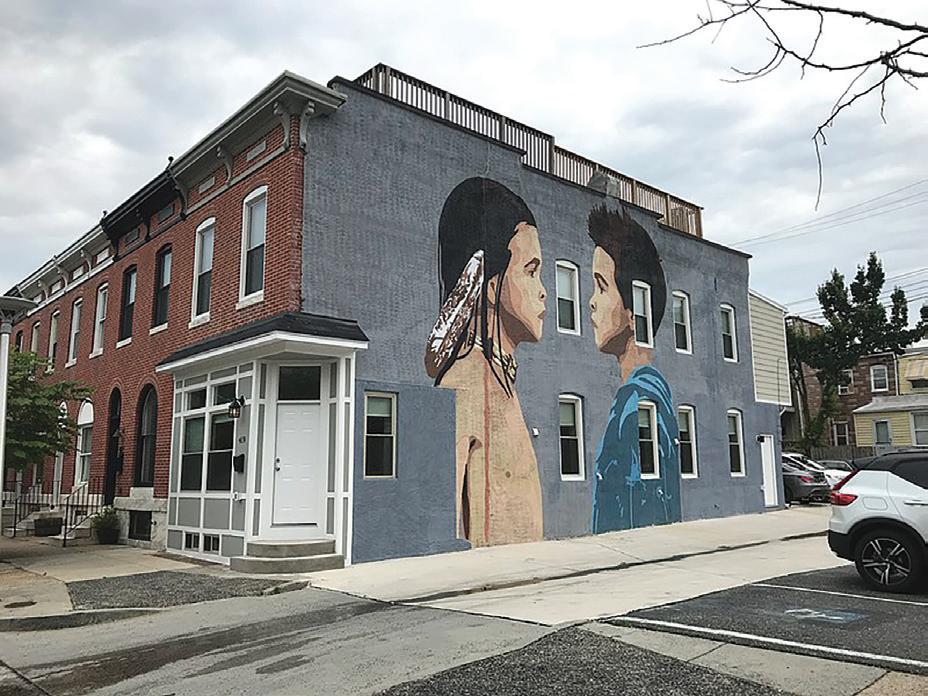
“Creating a truly equitable environment for
October U.S. Jobs Report Proves Better than Economists Predicted
By Stacy M. Brown NNPA Newswire Senior National CorrespondentThe latest government report shows widespread job gains across various industries, including health care, professional and technical services, and engineering.
The report issued on Friday, Nov. 4, revealed that the market remains robust, even more so than what financial experts predicted.
More than 261,000 jobs were added by employers
BakersfieldNews Observer
Adjudicated a Newspaper of General Circulation Au gust 11, 1980, Kern County Superior Court Decree, Case No. 16964, Government Code 6023.
Bulk Mailing Permit 724 Bakersfield, CA 93385
Published By Observer Group Newspapers of South ern California, Inc. Corporate Office 1219 20th St. Bakersfield, CA 93301 (661) 324-9466.
President: Ellen Coley CEO: Jon Coley Publisher/ Editor: James Luckey Jr. Operations Manager: James LuckeyCredo-The Black Press believes that Ameri ca can best lead the world away from racial and national antagonisms when it accounts to every person, regardless of race, color, or creed full hu man and legal rights. Hating no person, fearing no person, the Black Press strives to help every person in the firm belief that all are hurt as long as any one is held back.
The Observer Group Newspapers reserves the right to publish views an opinions that may not necessarily reflect those of the staff and man agement and are solely the product of the re sponsible individuals who submit commentaries published in these newspapers. Letters, articles and comments appearing in the Observer News papers reflect the opinions of the contributor and do not constitute the opinion or endorsement by The Observer Newspapers or its staff. The Ob server Group Newspapers assumes no responsi bility for photographs, articles, letters, press re leases and unsolicited materials. Decisions as to the editing and publishing of materials are at the discretion of the Publisher and Editors. All rights are reserved on materials accepted for publica tion unless otherwise specified.
Bakersfield News Observer
The Valley’s News Observer
The Valley’s News Observer
1219 20th St. Bakersfield, Ca 93301 Mailing Address P.O. Box 2341 Bakersfield, CA 93303 Phone (661) 324-9466 Fax (661) 324-9472 Emails and general info: observernews@gmail. com, Advertising: observeradvertising@gmail. com Available online: www.ognsc.com
in October, while the unemployment rate came in at 3.7 percent.
Economists had predicted about 205,000 new jobs.
Leading the way, health care realized a gain of 53,000 new jobs, while professional and technical services added 43,000.
Additionally, manufacturing saw 32,000 new jobs, while the leisure and hospitality industry added 35,000.
“Today’s jobs report – adding 261,000 jobs with the unemployment rate still at a historically low 3.7% – shows that our jobs recovery remains strong,” President Joe Biden said.
“With jobs now added every single month of my presidency, a record setting 10 million job increase, a record 700,000 manufacturing jobs added which puts us at 137,000 more manufacturing jobs than we had before the pandemic, historically low Black and Hispanic unemployment rates, the gross domestic product increasing, and incomes on the way up, one thing is clear: while comments by Republican leadership sure seem to indicate they are rooting for a recession, the US economy continues to grow and add jobs even as gas prices continue to come down.”
The president called inflation America’s top economic challenge.
“I know that American families are feeling squeezed. The global inflation that is raging in other countries is hitting us as well,” Biden stated.
“I’ve got a plan to bring costs down, especially for health care, energy, and other everyday expenses. And we’re already making progress – the cost of gas at the pump is down over $1.20 a gallon since this summer.”
He said the plan Republicans have put forth “is very different.”
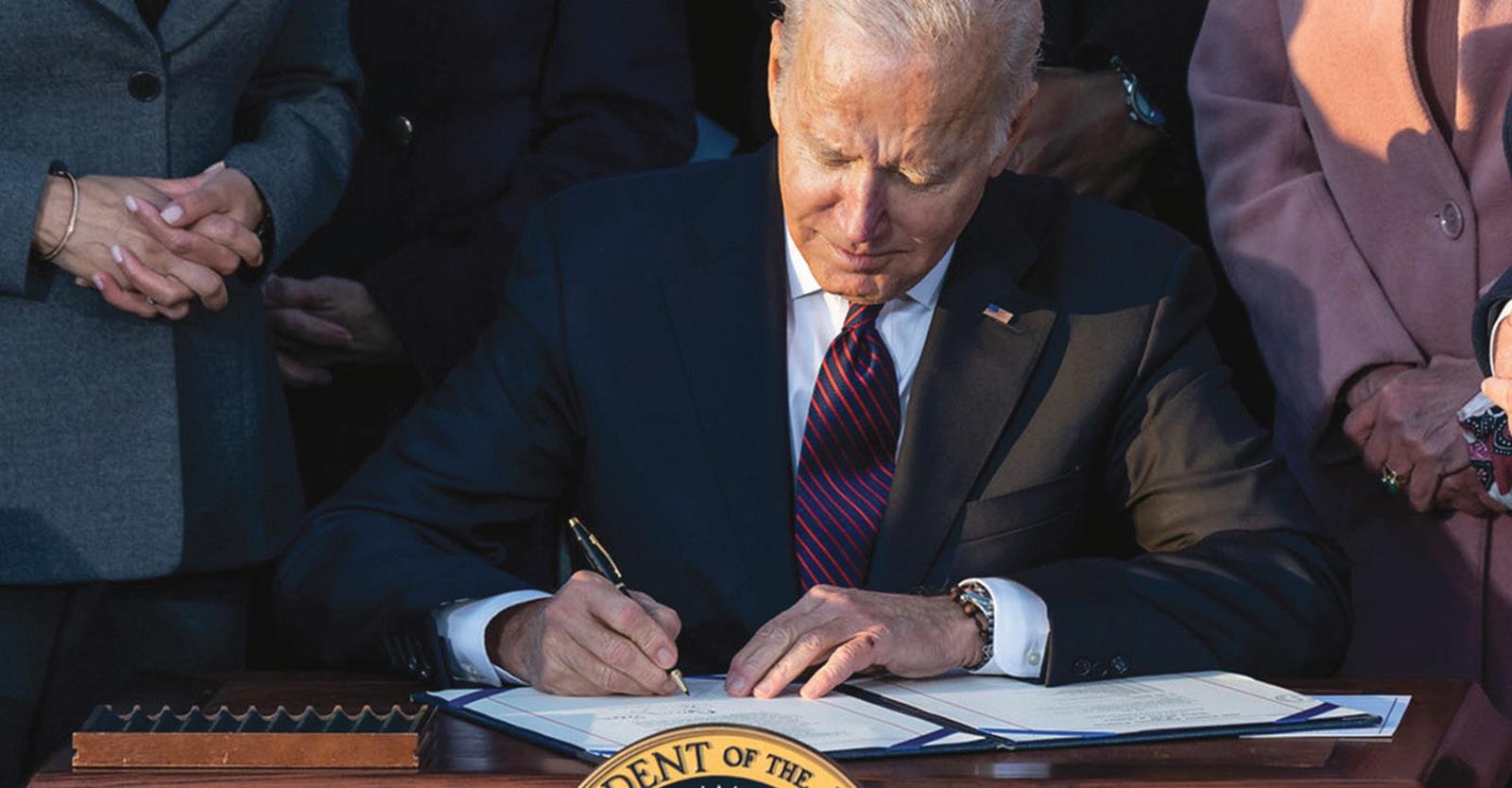
“They want to increase prescription drug costs, health insurance costs, and energy costs, while giving more tax breaks to big corporations and the very wealthy,” Biden
asserted.
“Here’s the deal: cutting corporate taxes and allowing big pharma to raise prices again is the Republican inflation plan and it’s a disaster.”
The president concluded:
“Let me be clear. We’re going to do what it takes to bring inflation down. But as long as I’m president, I’m not going to accept an argument that the problem is that too
many Americans are finding good jobs.
“Or that too many working Americans finally have more dignity in the workplace. Or that our largest, most profitable corporations shouldn’t have to pay their fair share.
“I will continue to work for an economy built from the bottom up and the middle out, not the top down as my Republican friends would have.”
Record Number of Black Candidates Seeking History During Midterm Elections
While some already are household names like
Abrams in Georgia, Val Demings in Florida, and
Brown in Maryland, others like Natalie James in Arkansas, Will Boyd in Alabama, and Stephanie Thomas in Connecticut, are upstarts.
All are among the approximately two dozen Black candidates seeking public office.
In some cases, a victory would make the individual the first African American to hold the top elected office in their state.
Here’s a breakdown of the candidates and the offices they’re running for in each state.
Democrat Natalie James seeks to unseat Republican John Boozman in the U.S. Senate race out of Arkansas.
A James victory would make her the first Black congress member from Arkansas. The so-called “Natural State” also would house its first Black governor if Democrat Chris Jones defeats Republican Sarah Sanders, the former White House Press Secretary under Donald Trump.
In Alabama, Democrat Yolanda Flowers has run a relentless campaign for governor against GOP incumbent Gov. Kay Ivey.
Flowers already counts as the first Black woman to win a major party nomination for governor in Alabama.
A Nov. 8 victory would make her the first Black woman governor in the Cotton State.
Meanwhile, Democrat Will Boyd is seeking the U.S. Senate seat out of Alabama, making him the first Black person in state history to hold that office. Boyd faces off against Republican Katie Britt.
In California, Republican Angela Jacobs seeks to unseat Eleni Kounalakis as the state’s lieutenant governor.
Jacobs would be the first Black woman to hold that office.
In Connecticut, Democrat Stephanie Thomas faces off against Republican Dominic Rapini in the race for secretary of state. Thomas would be the first Black woman to hold that seat.
In Florida, Democratic Rep. Val Demings faces Republican Marco Rubio in the race for U.S. Senate. With a victory, Demings, Orlando’s first woman police chief, would be the first Black person to represent the Sunshine State in the U.S. Senate.
Also in Florida, Aramis Ayala is running against incumbent Republican Ashley Moody in the state attorney general’s race. A win would make Ayala Florida’s first Black attorney general.
In Georgia, Abrams continues to fight an uphill battle in her rematch with Republican Gov. Brian Kemp. Abrams again attempts to become the first Black woman to governthe Peach State.
In Iowa, Deidre DeJear, a Democrat, is trying to become the first Black woman governor in her race against incumbent Republican Kim Reynolds.
Charles Booker, a Kentucky Democrat, is trying to upset incumbent Republican Rand Paul for the state’s U.S. Senate seat.
In Louisiana, Gary Chambers, a Democrat, is viewed as a longshot against incumbent Republican John Kennedyin the race for the Senate. Chambers would become the first African American to represent Louisiana in the U.S. Senate.
In Maryland, Wes Moore seeks to become the state’s first Black governor. The Democrat faces off against Republican Dan Cox.
Meanwhile, Democratic U.S. Rep. Anthony Brown is running to become Maryland’s first Black attorney general.
Republican Michael Peroutka is his opponent.
Former Boston City Council President Andrea Campbell, a Democrat, has her sights on Massachusetts’ attorney general’s office. Campbell would become the firstBlack woman to hold that seat in the state if she defeats
Republican Jay McMahon.
Republican Rayla Campbell, no relation to Andrea, is seeking to unseat Democrat William Galvin to become thefirst Black woman to hold that office.
In North Carolina, Democrat Cheri Beasley squares off against Republican Ted Budd for the U.S. Senate seat. Beasley is attempting to become the first Black woman in state history to win the election to that chamber.
New York Republican Joe Pinion, a Black man, is running against longtime Democrat incumbent ChuckSchumer in the race for U.S. Senate.
New York has never had a Black senator.
In Ohio, Democrat Chelsea Clark faces Republican Frank LaRose in the race for secretary of state. Ohio has never had a Black woman in that role.
Meanwhile, Pennsylvania has never had a Black lieutenant governor, something Democrat Austin Davis hopes to accomplish in his race against Republican CarrieDelRosso.
In South Carolina, Democrat Krystle Matthews, a Black woman, faces incumbent Tim Scott for the U.S. Senate seat.
A Black woman has never represented South Carolina in the U.S. Senate.
Mandela Barnes is attempting to become the first Black senator out of Wisconsin. Barnes, a Democrat, faces GOP Sen. Ron Johnson.
Jay-Z Reportedly Might Team with Jeff Bezos to Buy the Washington Commanders
Jay-Z
Reports surfaced Thursday that the “99 Problems” artist is mulling a bid to purchase the Washington Commanders from Dan Snyder.
While Jay-Z isn’t commenting on the prospect, TMZ reported that a partnership between Beyonce’s husband and Jeff Bezos “is on the table.”
The news arrives just one day after Snyder hired a major bank to investigate selling the team.
Of course, Jay-Z and Bezos aren’t the only potential suitors.
The team’s former quarterback Robert Griffin III has openly courted backers on social media.
“Who wants to be a minority owner of the Washington Commanders? I’m down to pay for a stake in the team and bring ten fans along for the ride,” Griffin tweeted.
“Ten fans don’t have to pay anything,” he declared.
Perhaps Jay-Z’s most significant competition would come in the form of media mogul Byron Allen, whom Bloomberg reported is working with a group of investors seeking to purchase the team.
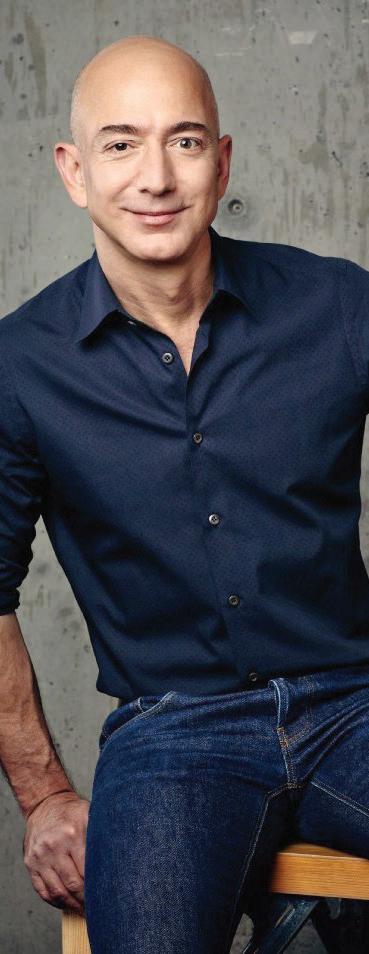
According to Bloomberg, Allen has said that NFL commissioner Roger Goodell and Patriots owner Robert Kraft approached him about bidding for the Broncos.
The latter was sold earlier this year to a group led by Walmart heir Rob Walton for $4.65 billion.
The Bloomberg report noted that one NFL franchise owner that the Commanders are expected to net a purchase price of at least $5 billion, with the possibility of the price tag reaching $6 or $7 billion.
Forbes places Jay-Z’s worth at about $1.5 billion, so the mogul would appear to need a partner in the endeavor. He previously owned a stake in the NBA’s Brooklyn Nets.
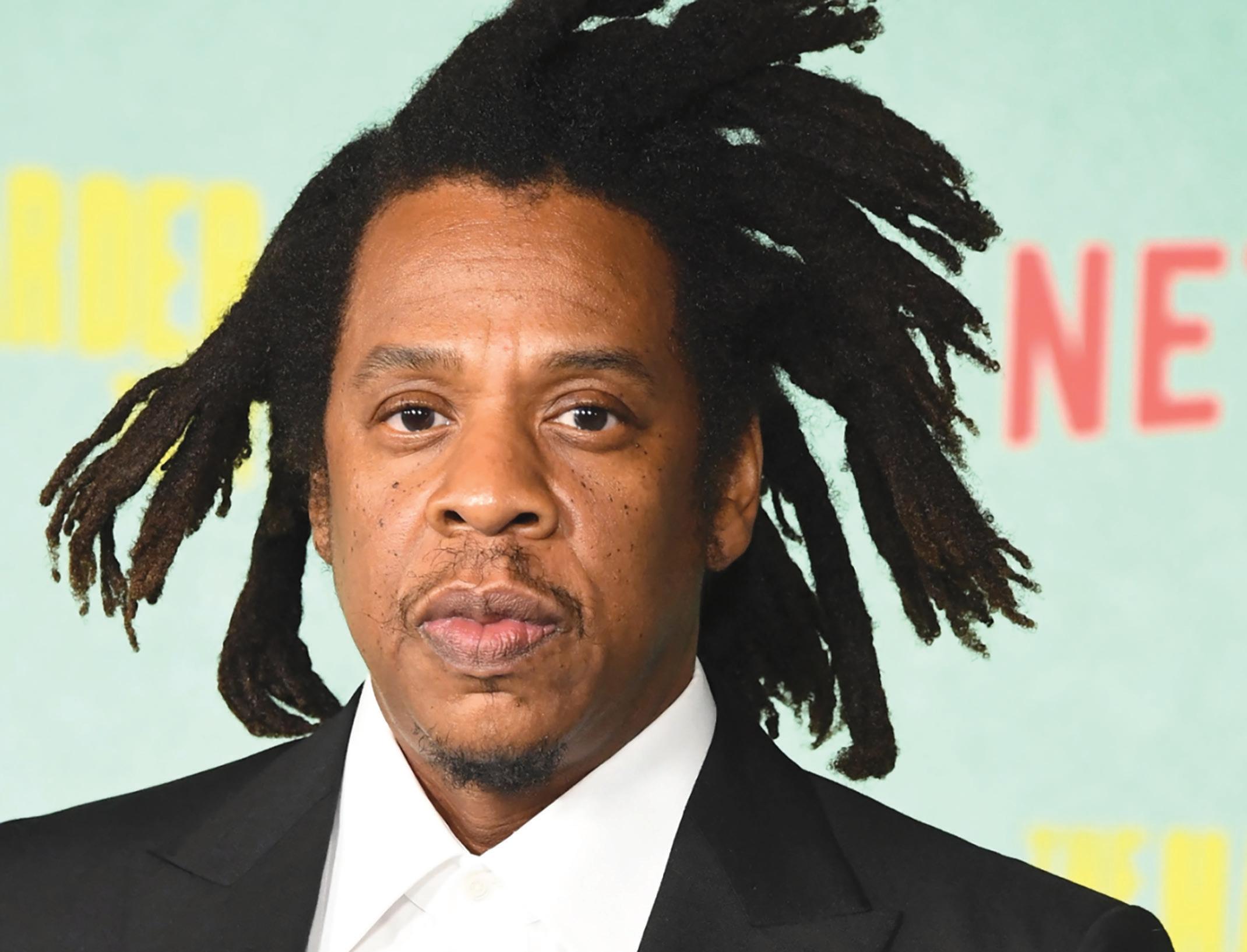
Migos Rapper Takeoff Shot Dead in Houston
By Stacy M. Brown NNPA Newswire Senior National CorrespondentThe continued spate of violence against Hip Hop artists has claimed its latest victim and one of the genre’s biggest names.
Takeoff, one-third of the super trio Migos, died early Tuesday after being shot in Houston.
TMZ reported that the shooting occurred shortly
after 2:30 a.m. with multiple witnesses on scene.
“We’re told Takeoff and Quavo were there playing dice when an altercation broke out and that’s when someone opened fire, shooting Takeoff either in the head or near his head. He was pronounced dead on the scene,” TMZ reported.
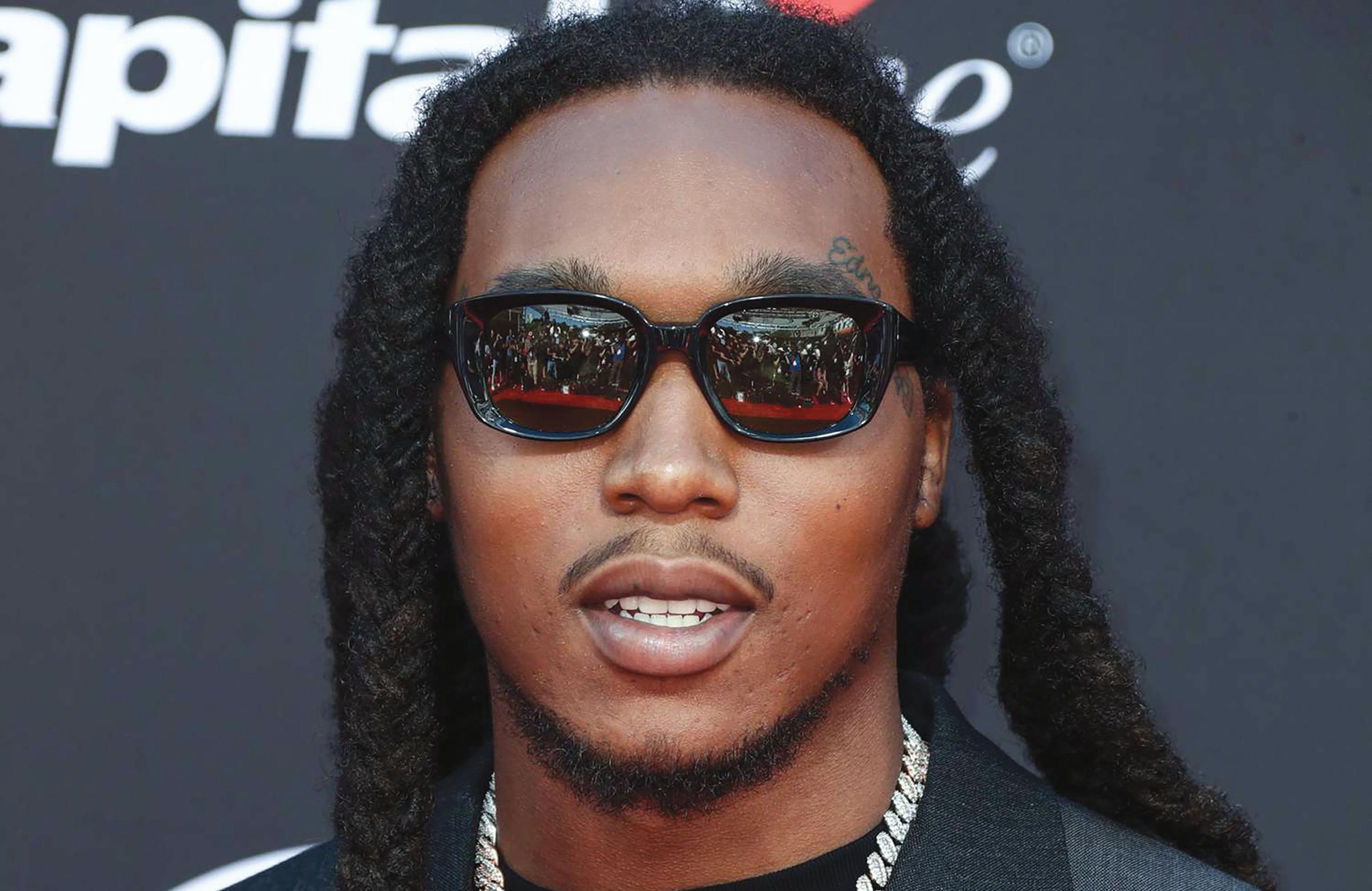
The outlet posted footage from the scene where Quavo and others are gathered around what appears to be
a profusely bleeding Takeoff.
“Police tell us 2 other people were shot and were taken to the hospital in private vehicles. It’s unclear what their conditions are. Quavo was not injured,” TMZ reported further.
Just a couple of hours before the shooting, Takeoff posted a selfie from the bowling alley. Quavo had posted video earlier in the night, driving around Houston with Jas
Prince, who was celebrating his birthday. Takeoff, whose real name is Kirshnik Khari Ball, was the youngest member of Migos. Quavo was his uncle and Offset his cousin.
They came together as a group in 2008 in Georgia and became multi-platinum hitmakers, releasing “Versace,” in 2013, and “Bad and Boujee” in 2016.
Features

Sacramento Civil Rights Group Accepts Benevolent Boon from Billionaire
In October, the Greater Sacramento Urban League (GSUL) received its biggest donation in the civil rights organization’s 54-year history.
Philanthropist, author and the ex-wife of Amazon founder Jeff Bezos, MacKenzie Scott, donated $2.4 million to the local chapter of the National Urban League (NUL) based in central California.
GSUL President and CEO Dwayne Crenshaw said in an Oct. 31 announcement that the Urban League is grateful to the billionaire for the donation and appreciates Scott and her team’s recognition of the group’s impact and value to the Sacramento area.
“By placing racial equity and social justice at the forefront of her philanthropic mission, Ms. Scott is shining a much-needed spotlight on the nation’s structural and institutional limitations and helping to build a stronger, more resilient society for everyone,” Crenshaw said.
According to the NUL, the Sacramento chapter was one of 25 Urban League affiliates that received over $100 million in contributions from Scott.
NUL President and CEO Marc. H. Morial expressed gratitude for the gift in a Nov. 1 statement.
“As the nation’s economic first responders, Urban League affiliates are the most effective and impactful engines of empowerment for eliminating racial gaps in our economic and justice systems,” Morial said.
The donated funds will go toward GSUL’s mission of empowering, educating, and employing youth and families from Black and other marginalized people to build thriving communities.

In particular, the monies will aid in the development of a mixed-use housing and community-serving building project on GSUL-owned land in Del Paso Heights, a neighborhood in North Sacramento.
The group hopes to break ground on the development, a community and economic revitalization project, late next spring, said GSUL spokesperson Laura Murrell. Murrell said Scott’s financial contribution will jumpstart the development.
Although it was the lone Urban League branch in the Golden State to receive a boon from Scott, GSUL wasn’t the only California organization to receive a donation from the well-heeled benefactress last month.
The Girl Scouts of the USA announced Scott gave $4.9 million to the Girl Scouts of Greater Los Angeles. The gift was part of an overall $84.5 million donation to the Girl Scouts of the USA.
The Girl Scouts of Greater Los Angeles, headquartered in Inglewood, serves more than 46,000 girls in partnership with 25,000 adult members and volunteers throughout the communities of Los Angeles County and parts of Kern, San Bernardino, and Ventura counties.
Sofia Chang, the Girl Scouts of the USA CEO, said in a statement that the charity is a great accelerator of efforts
to give girls the tools to become the next generation of powerful leaders.
“We’re excited to prove how Ms. Scott’s investment in girls will change the world -- because when one girl succeeds, we all succeed,” Chang said.
Several other groups across the nation also announced they had received monetary aid from Scott last month.
However, no indication of the donations came from Scott, who has a net worth of $27 billion and has given away around $12.7 billion to more than 1,200 nonprofits since July 2020, according to Forbes. Scott does not give media interviews or make public appearances.
Since she supercharged her charitable giving after her divorce from Bezos in 2019, Scott has at times acknowledged her gifts on the blogging site Medium. As of press time, her last post on the website was in March.
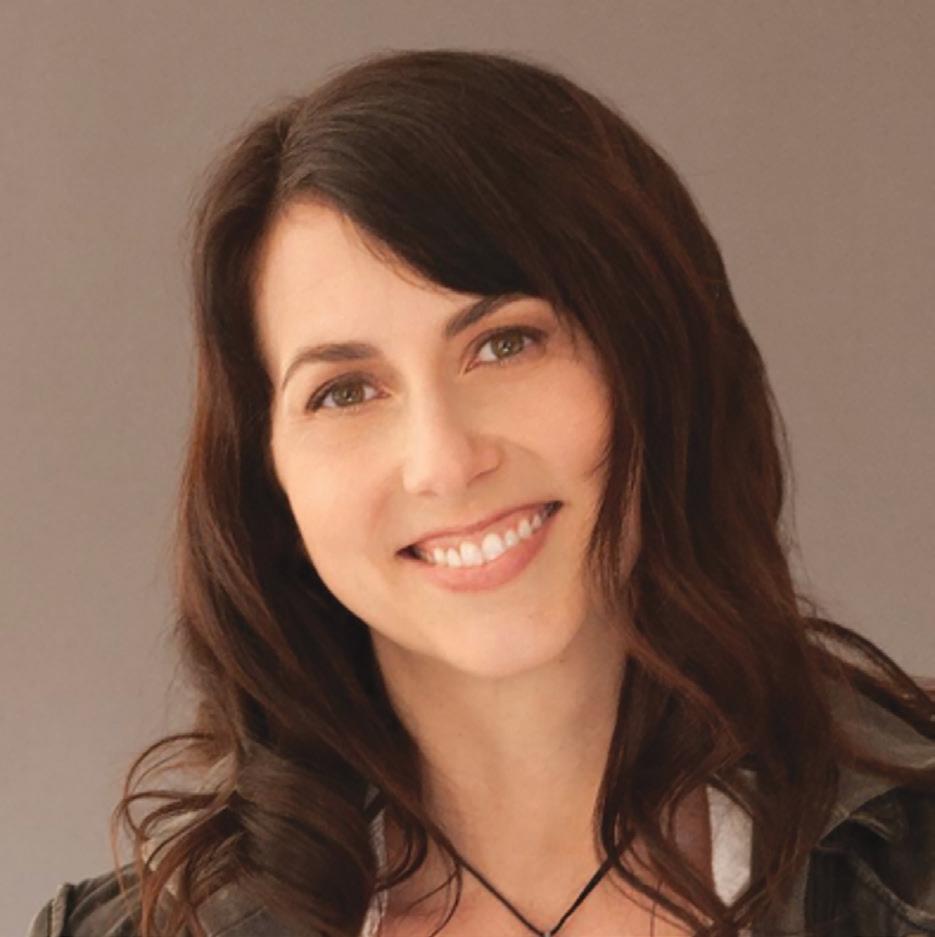
In the post titled, “Helping Any of Us Can Help Us All,” Scott acknowledged 465 nonprofits she had given funds to since last June and typed, “as always, our aim has been to support the needs of underrepresented people from groups of all kinds. The cause of equity has no sides.”
Murrell, the GSUL spokesperson, said the organization was shocked by Scott’s charitable gift.
“She has a reputation of giving very generous donations to countless organizations across the U.S. that do incredible work. So, to have her recognize the Urban League and our Sacramento affiliate in particular was astounding,” Murrell recalled.
Past Tweets Reveal Clues about Twitter’s New Owner
By DAVID KLEPPER Associated PressHe may be good with rockets and electric cars, but don’t turn to Elon Musk for public health predictions.
“Probably close to zero new cases in US too by end of April,” the world’s richest man tweeted about COVID-19 in March 2020, just as the pandemic was ramping up.
It’s one of many tweets that offer a glimpse into themind of Twitter’s new owner and moderator in chief. Playful, aggressive and sometimes reckless, Musk’s pasttweets show how he has used social media to tout his businesses, punch back at critics and burnish his brand as a brash billionaire who is unafraid to speak his mind.
Musk joined Twitter in 2009 and now has more than 112 million followers – the third most of any account after former president Barack Obama and Canadian singer Justin Bieber. He had long mused about purchasing the platform before the $ 44 billion deal was finalized last week.
Musk hasn’t detailed the changes he intends to make at Twitter, though he wasted no time in making widespread layoffs. But he has said he wants to make Twitter a haven for free speech. He’s said he disagrees with the platform’s decision to ban ex-President Donald Trump for inciting violence ahead of the Jan. 6, 2021 assault on the U.S. Capitol.
“I hope that even my worst critics remain on Twitter, because that is what free speech means,” Musk tweeted
earlier this year when he announced his intention to buy the platform.
As the CEO of Tesla and SpaceX, Musk uses his Twitter account to make business announcements and promote his enterprises. He muses about technology and trade, but has also posted jokes about women’s breasts and once compared Canada’s prime minister to Hitler. He regularly weighs in on global events, as he did in March 2020 when he tweeted that “The coronavirus pandemic is dumb.”
That same month, he tweeted that children were largely immune from the virus and predicted that cases would soon disappear.
Musk has also used his Twitter account to weigh in other big news events – with mixed results.
This fall, Musk infuriated leaders in Ukraine when he went on Twitter to float a potential peace deal. Under Musk’s plan, Russia would get to keep Crimea, which it seized from Ukraine in 2014, and Ukraine would have to drop its plans to join NATO.
Musk also suggested that people living in other areas illegally annexed by Russia should vote on whether Russia or Ukraine should get control over the territories – a move that Ukraine supporters said would reward Russia for its illegal aggression.
“The danger here is that in the name of ‘free speech,’ Musk will turn back the clock and make Twitter into a more potent engine of hatred, divisiveness, and
misinformation,”said Paul Barrett, a disinformation researcher and the deputy director of New York University’s Stern Center for Business and Human Rights.
Stern singled out Musk’s comments about Ukraine as particularly concerning. ‘’This is not going to be pretty,’’he said.
Just days after purchasing Twitter Musk waded into yet another firestorm when he posted a link to an article advancing a bizarre conspiracy theory about the attack on the husband of U.S. Speaker Nancy Pelosi. The article suggested that Paul Pelosi and his assailant were lovers, even though authorities said the suspect confessed to targeting the speaker and did not know her husband.
Musk later deleted the tweet without explanation.
Musk has long used the megaphone of his Twitter account to punch back at critics or people he opposes, such as when he attacked a diver working to rescue boys trapped in a cave in Thailand by calling him a ‘’pedo,’’ short for pedophile. The diver had previously mocked Musk’s proposal to use a sub to rescue the boys. Musk, who won a defamation suit filed by the diver, later said he never intended “pedo” to be interpreted as “pedophile.”
Three days before Elon Musk agreed to buy Twitter, the world’s richest man tweeted a photo of Bill Gates and used a crude sexual term while making a joke about his belly.
Earlier this year he criticized the Twitter executive in charge of the platform’s legal, policy and trust divisions. In
response to his tweets about the executive, many of Musk’s followers piled on with misogynistic and racist attacks, in addition to calls for Musk to fire her when his purchase of Twitter was approved.
Musk fired the executive on day one.
Musk’s use of Twitter has at times led to problems for his own companies. In one August 2018 tweet, for instance, Musk asserted that he had the funding to take Tesla private for $420 a share, although a court has ruled that it wasn’t true. That led to an SEC investigation that Musk is still fighting.
Last year another federal agency, the National Labor Relations Board, ordered Musk to delete a tweet that officials said illegally threatened to cut stock options for Tesla employees who joined the United Auto Workers union.
Those tweets helped cement Musk’s reputation as a brash outsider. But that doesn’t mean he is equipped to run a social media platform with more than 200 million users, said Jennifer Grygiel, a Syracuse University professor who studies social media. Grygiel has assigned Musk’s tweets as reading material for students.
“Look at the feed: It’s all over the place. It’s erratic. At times it’s pretty extreme,” Grygiel said. “It paints him as some sort of rebel leader who will take control of the public square to save it. That is a myth he has constructed.”
Features
Chuck D on Death of Takeoff:
‘When Corporations Show Up God Leaves the Room’
By Stacy M. Brown NNPA Newswire Senior National CorrespondentAs family, friends, and fans, continue to mourn the death of Migos member Takeoff, the demand for hip-hop to take a stand against gun violence has grown.
While many have expressed disbelief and anger that the shooting death of the 28-year-old, whose real name is Kirshnik Khari Ball, took place allegedly because of an argument over a dice game.
Fans on social media and the mainstream press have quickly tossed blame at everyone from Takeoff’s bandmate Quavo to clothing boss J. Prince Jr. and even to the slain rap star himself.
And as always, hip-hop has come under fire.
That’s no surprise to legendary Public Enemy frontman Chuck D, whom most recognize as hip-hop’s voice of reason.

In putting in a perspective as perhaps only the “Fight the Power” artist can, Chuck noted that any other industry that has seen as many fatalities as hip-hop would have addressed that issue long ago.
And Chuck doesn’t put the blame entirely on the artists.
“This curiosity of what is this hip-hop thing, what is this Black thing. The world always seems to want to know and mimic our greatness,” Chuck asserted in a 30-minute interview with the Black Press of America’s live morning news program, “Let It Be Known.
“And if they can find a way to finance and have our people mimic us at our worst – the stereotype that generalizes us as a bunch of murderous thugs and metastasize that over a 10-15-20year period as being normal, then we got a problem.”
He continued:
“I don’t blame the youth. You’ve got to blame some adults hiding behind the scenes, pied piping and pied papering all of this madness and making this kind of thing seem normal. Was there a shootout at a dice game? Yes. Were Black men involved in that circle? Yes. But it’s somebody pushing buttons and pulling levers and not only doing so but they have been greatly enriched financially by these incidents.”
Takeoff’s death counts among a string of murders in the hiphop community over the past several years.
Other high-profile murders include PnB Rock, Pop Smoke,
XXXTentacion, Nipsey Hustle, King Von, and Young Dolph.
“I was in college when Biggie and ‘Pac was killed and thought there was no way we’d ever experience anything remotely close to that again,” media personality Jemele Hill tweeted following Takeoff’s death.
“Now,” Hill continued. “It’s happening so frequently that you barely have time to recover before someone else is killed.”
Chuck noted that a large part of the argument about hiphop deaths and violence comes from many who don’t consider all available facts.
“There are hundreds of thousands of artists out there,” he said when asked whether the younger artists pay attention to the
old heads.
“Who do you count? Do you count the more successful ones because more people like them? When we start getting into followers and likes, those algorithms don’t add up to who we are as a people,” Chuck insisted.
He explained:
“I have ten stations on Rap Station (Radio). We play artists from the underground and under-found. We play artists with a 10-15-year career, women worldwide and in more abundance than in the United States.”
Chuck continued: “If you only pay attention to what’s being washed up on
your shores, you’re going to get a limited view of what it really is. There is really no kind of educational forum that people can go to like in other aspects of life. Our arts and culture should be taught to us. If we don’t control our educational curriculum, we’re going to let corporations teach us. And, whenever corporations show up, God walks out the door.”
In a recent podcast, Takeoff spoke about receiving his flowers before he died.
“It’s time to pop it,” Takeoff said on “Drink Champs.”
“It’s time to give me my flowers. I don’t want them later when I’m not here. I want them right now.”
Chuck said the life artists today lead, compared to earlier hip-hop stars, is different.
“At the beginning of hip-hop, especially in the real beginning, cats wanted to get away from that,” Chuck recounted.
“They didn’t want to be in the Bronx. New York City had been deemphasized and abandoned by the U.S.A. during a tough fiscal time post-Nixon. Cats saw the emergence of hard drugs coming in out of nowhere. Guns coming out of nowhere, and cats wanted to get away from that, and they didn’t want to [rhyme] about that in the 1980s.
He concluded:
“You had MCs and rappers who adhered to those values and qualities. We could have “The Message” by Grandmaster Flash and the Furious Five that talked about what’s going on, but they also made party records to not talk about things people saw every day.
“There was a balance to at least try to bring good times into the picture. People often said Public Enemy bought a political message, but we came from the 1960s, so we remember a time of being broke but not broken.
“Many cats came from the 1970s doing hip hop in the 1980s and 1990s.
“We came from the Black Panther Party doing lunch programs, the Nation of Islam doing things in the neighborhood. We remember Dr. Martin Luther King and Malcolm X being assassinated when they were living people to us.
“On my birth certificate, it says ‘Negro.’ I remember being ‘Colored’ and ‘Black is Beautiful.’ That’s a different period that has been kind of pushed under the rug in Americana.”
Chavis Declares ‘A Luta Continua’ as Black Press Set to Honor Icon with Lifetime Achievement Award
By Stacy M. Brown NNPA Newswire Senior National CorrespondentWhen the National Newspaper Publishers Association (NNPA) removed the interim president and CEO tag from Dr. Benjamin F. Chavis Jr. in 2014, then NNPA Board Chair Cloves Campbell conveyed to the membership that the civil rights icon possessed the talent and contacts to make an immediate impact.
Campbell, the publisher of the Arizona Informant, also highlighted another of Chavis’ intangibles from which Black-owned media companies would benefit: energy.
Eight years later, and a decade after running the NNPA on an interim basis, Chavis, has continued to display the kind of energy seen primarily in individuals less than half his age.
He’s also led the NNPA, representing the 195-yearold Black Press of America, to financial prosperity when newspapers and media companies universally struggle to keep the doors open.
Among the most recent accomplishments under Chavis, the Black Press finally received all-access to the White House.
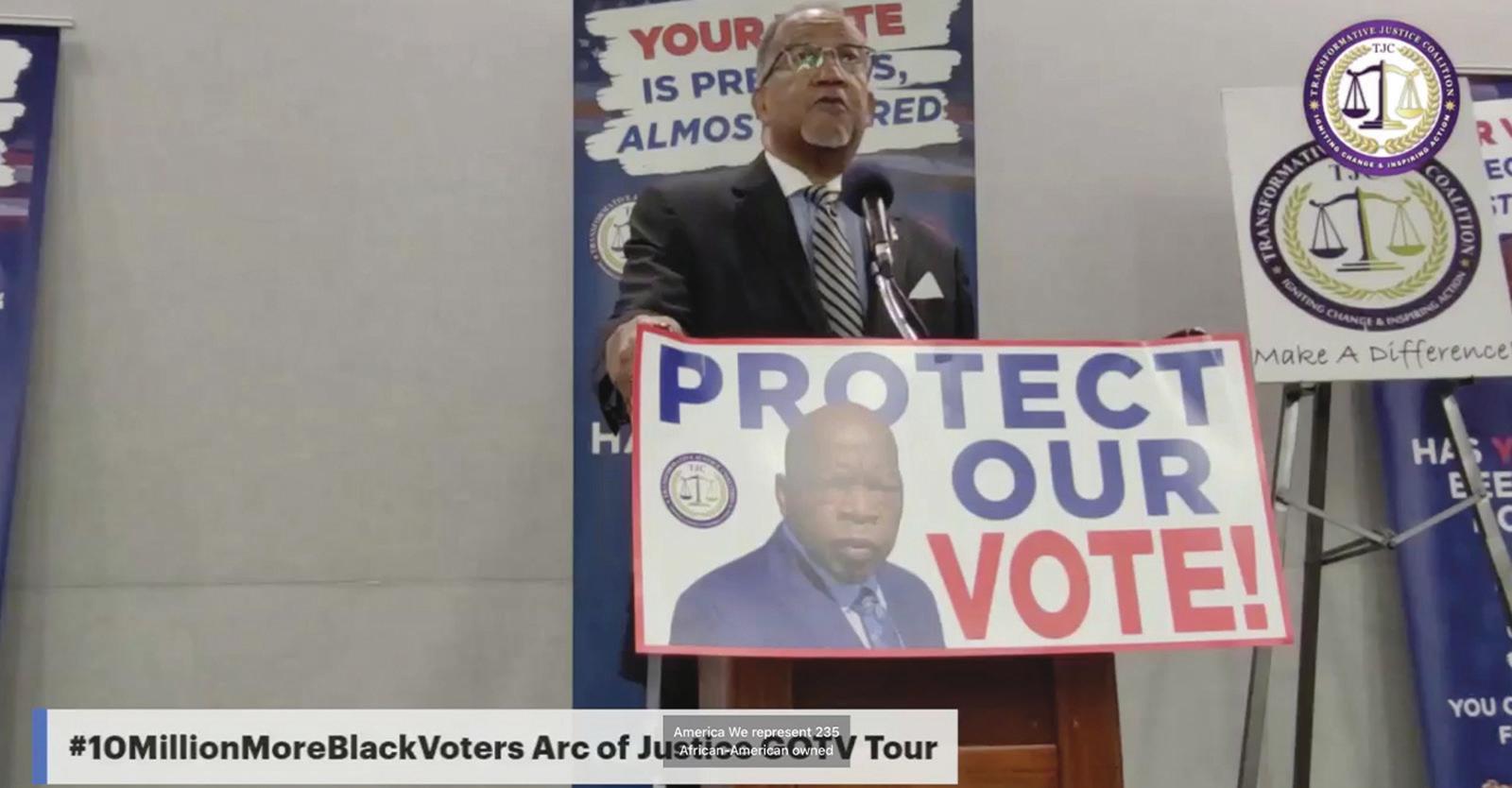
It was Chavis leading a large contingent of Black Press publishers to Charleston, South Carolina, during the 2020 primary season where they met with candidate Joe Biden.
At the time, Biden trailed mightily in the polls and needed a victory in Dixie to survive. Chavis’ interview with Biden went viral, the former vice president then received a crucial endorsement from Rep. James Clyburn (D-S.C.), won the primary, and his campaign rode the wave all the way to the White House.
He’s also brokered deals with or strengthened partnerships with the Bill & Melinda Gates Foundation, GM, Reynolds, AARP, API, and many others.
As he traversed the globe – in protective gear – during the pandemic, Chavis, by his actions and deft deal making, often reminded publishers, partners, sponsors, employees, and others of the catchy slogan he’s lived by since he was a wide-eyed 14-year-old serving in the Southern Christian Leadership Conference under Dr. Martin Luther King Jr. “A luta continua” – or “the struggle continues.”
Because of his dedication and steadying hand, the historic all-Black woman board of the NNPA unanimously has chosen Chavis as the recipient of the NNPA Lifetime Achievement Award.
They will present the honor at a special gala during the NNPA’s annual midwinter training conference.
With the theme, “Digital Innovation, Training, and Engagement of the Black Press of America,” the conference convenes on Feb. 1 at the brand-new Westin Beach Resort at Frenchmen’s Reef, Estate Bakkeroe, in St. Thomas, U.S. Virgin Islands.
“I’ve very honored to be considered by the NNPA for this esteemed award,” Chavis remarked.
“I do believe that, if anything, my life represents a life of a freedom fighter. However, I want to emphasize that accepting this ward in no way should be interpreted as
saying that the struggle for freedom has been completely won.”
Chavis continued:
“We’ve made tremendous progress in the last 100 years, but we still have a lot of progress and freedom to fight for.
“If I’ve learned anything over my last 75 years, it’s that when you win freedom to any extent, you must fight to preserve that freedom. You must fight to protect that freedom, endow that freedom, and sustain that freedom.
“Thus, I’m not willing to retire from being a freedom fighter. So, I accept this award as an incentive to keep fighting for freedom for people of African descent, Americans, and those worldwide.”
Chavis has a well-documented history.
The leader of the Wilmington 10 political prisoners, Chavis is also renowned for his early fight for environmental justice.
In the 1980s, he coined the term “environmental racism.”
Chavis has advised many prominent politicians and entertainers – many like Hip Hop and Business Mogul Russell Simmons, refer to Chavis as a mentor.
A former NAACP president, Chavis organized the Million Man March and co-founded the Hip Hop Summit with Simmons.
A younger generation of admirers still approaches Chavis in awe of his appearance in the hip hop classic movie drama, “Belly.”
Many of all ages continue to revere Chavis as a civil rights leader and a reverend.
“Dr. Chavis has given meaning to the words of Micah 6:8 in the Bible,” said San Diego Voice & Viewpoint Publisher Dr. John Warren.
Quoting the King James Bible, Warren said of Chavis, “And what does the Lord thy God require of thee, but to do justly, and to love mercy, and to walk humbly with thy God.”
Chavis has served the NNPA and “the people of this country with honesty, integrity, and selflessness, without looking for awards, recognition, or accolades,” said NNPA Vice Chair and Atlanta Voice Publisher Janis Ware.
“Today, we celebrate a man who leads with heart, love for his God, and all people from all walks of life. He is truly a rare human being. One to go down in the annals of human history as special and one for the ages.”
NNPA Treasurer and Texas Metro News Publisher Cheryl Smith also praised Chavis for having “led a life of service.”
“He is a true servant leader who has his finger on the pulse of our people, our communities, and the world,” Smith asserted.
“I am so appreciative of his leadership, wisdom, and support,” she added.
NNPA Fund Chairman and Los Angeles Wave Publications CEO Pluria Marshall Jr. called Chavis a potent and stabilizing force.
“For more than ten years, Ben has been a potent and stabilizing force for NNPA and its nonprofit NNPA Fund,” Marshall insisted.
“He is a visionary consensus builder and community advocate whose calm and deft communication skills have helped make the Black Press an even stronger media force in America.”
Marshall continued:
“From his longtime commitment to civil rights to his ardent passion for equity and justice, Ben has consistently proven himself to be the consummate public servant.
“He is more than deserving of this lifetime achievement award, and I am pleased to endorse his selection to this prestigious honor.”
Chavis noted that those sentiments mean a great deal.
“This award is particularly significant because it comes from my colleagues, fellow publishers, journalists, editors, and writers,” Chavis said.
“It reminds me of what James Baldwin reminded me of when he said the pen is mightier than the sword.”
“I’m thankful I’ve been able to use my pen as an instrument for freedom. I accept this award on behalf of the Chavis family, a freedom-fighting family fighting for freedom worldwide for over 250 years.”
Westside Gazette Publisher Bobby Henry said it’d been some time since someone has stood on the shoulders of history makers to demand freedom, justice, and equality for all, particularly for Black people after enduring suffering because of the fight.
“I am one to say, because of the strength, courage, and fortitude of the Rev. Dr. Benjamin F. Chavis Jr., the Black Press of America, the NNPA, and the world are better because of him,” Henry asserted.
“Congratulations, Dr. Chavis. A luta continua.” While preparing for the conference, Chavis said he was far from finished.
“When I came to this job ten years ago, I came with a sense of optimism,” Chavis recalled.
“Now, ten years later, my optimism has increased exponentially because I see the potential of the Black Press. I’m very pleased to see so many young Generation Z journalists, writers, photographers, and content creators.”
“I think the future in this digital space … it’s not just that we should be in this space but leading the space forward. So, my optimism is still intact and has increased because I’ve seen not only the expansion and success of the Black Press over the last decade, but I’ve seen glimpses of the brighter future ahead.
“The biggest challenge is the economic and equity question. We must work on that to sustain Black-owned businesses, particularly Black-owned media, economically and equitably. That’s the next hurdle, and I will live out my years making sure that we don’t miss a beat in improving the economic equity of Black-owned businesses and Blackowned media companies.”
For discounted resort rates for the NNPA Midwinter Training Conference in St. Thomas, and for more information, visit www.nnpa-events.com.
Covered California Enrollment Launched
- Healthcare Help Available for All
Maxim Elramsisy
California Black Media

California’s health insurance marketplace, known as the Covered California Health Exchange, launched its 10th open enrollment period on Nov.1.
Covered California is the government agency that offers subsidized Obamacare plans for Californians. Those who qualify receive financial assistance on a sliding scale for their health coverage in compliance with the Affordable Care Act (ACA). Depending on income, some consumers may qualify for another state-provided health insurance option, Medi-Cal, at a lower or no cost.
U.S. Secretary of Health and Human Services Xavier Becerra joined Congresswoman Karen Bass (D-CA-37), Los Angeles Mayor Eric Garcetti and other Covered California leaders at Union Station in Los Angeles to kick off open enrollment.
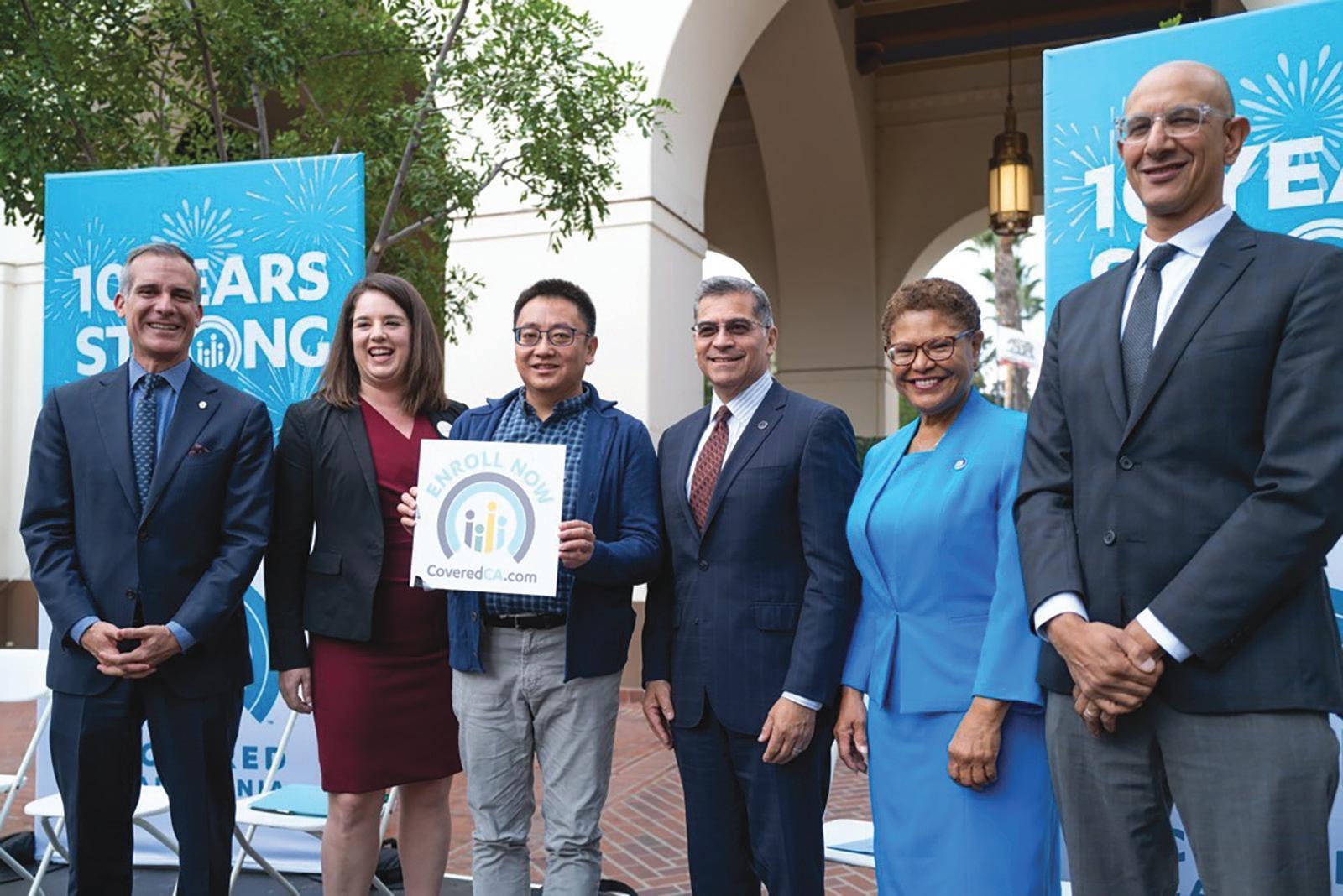
“We saw from COVID how many gaps there are in our health public health care system. First and foremost, we’ve got to get people covered. They know they have that peace of mind if they can walk into any doctor’s door, into any hospital. It gives them the confidence to do it the right way,” said Becerra. “That’s why we’re going to continue to expand. When you can offer an American health insurance plan for 10 dollars or less a month; you can’t go see a movie today, not in LA, for 10 dollars… 10 dollars or less a month for peace of mind. That’s what we’re selling.”
Since Covered California’s first open enrollment campaign in 2013, federal data shows that California’s uninsured rate fell from 17.2% to a record low of 7.0%, the greatest percentage decrease for any state in that period, and below the national average of 8.6%.
Publicly funded Certified Enrollment Counselors, or “navigators,” provide consumers with free, unbiased advice as they look for health insurance options available on the marketplace. They help complete eligibility and enrollment forms and they assist with outreach, education, and renewal support services.
“We just came out with a report that showed that in the past year, because we went out to where you were to try to get to you, especially with our navigators, we saw a rise in the number of African American enrollees by 49%. And we saw a rise in the number of Latino enrollees by 53%,” said Becerra.
Still, according to estimates from Covered California, 1 million people are uninsured and eligible to get insured with lowcost or no-cost plans.
“Regardless of your income, if you need health insurance or if you’re covered directly through a health insurance company, come to Covered California to see if you can get financial help to make your insurance more affordable,” said Jessica Altman, Executive Director of Covered California. “The increased and expanded help that was extended by the Inflation Reduction Act is changing lives by helping more Californians get covered and stay covered.”
Getting and maintaining coverage is a critical first step that cannot be overstated, some health advocates say, but the healthcare system still has opportunities to better serve Black Californians. A recent California Healthcare Foundation (CHCF) survey found that 90% of Black Californians have health insurance coverage, but nearly one in three reported being treated unfairly by a healthcare provider because of their race or ethnicity.
“Just because Black folks are covered, doesn’t mean they are getting quality care,” said Congresswoman Bass, a former
physician’s assistant. “That has nothing to do with Covered California per se. It has to do with the inequities in the healthcare system. And having worked in the healthcare for a long time, I know that those inequities exist, and its across class. So, when Beyoncé and Serena Williams almost lose their life after a normal childbirth, it’s indicative of problems that are related specifically to race.”
The best remedy at this time is engagement. According
to the CHCF survey, two thirds of Black Californians report researching a health condition or concern before meeting with a healthcare provider to mitigate potential negative experiences, an observation Congresswoman Bass agrees with.
“The main thing that people can do is make sure that they are well educated. In other words, when you go to a doctor, don’t just leave it 100% up to the doctor, study up on what they are saying,” Bass said. “We need to have advocates inside of healthcare
who are trained - sometimes there are medical social workers who do that.”
Californians can explore their options at CoveredCA.com or by calling Covered California at (800)300-1506. They can easily find out if they qualify for financial help and see what coverage options are available.
The open enrollment period will continue until Jan. 31, 2023.
California Is Facing A “Tripledemic” Threat As Respiratory Illnesses Surge
By Victoria Rodgers South Kern SolAn increase in the number of cases of COVID-19, the flu, and respiratory syncytial virus (RSV) is prompting concern across California communities as threats of three coinciding epidemics — a “tripledemic” — are looming ahead of the upcoming holiday season.

“The data currently available shows that the rates of RSV are higher than normal for this time of year. In addition to the abnormally high levels of RSV, flu activity has been increasing and modeling is predicting a modest rise in COVID activity,” stated Michelle Corson, Program Manager/Public Relations Officer with the Kern County Public Health Services Department. “This results in three different illnesses circulating in the community, increasing the likelihood of somebody contracting one or more of these diseases.”
According to the California Communicable diseases Assessment Tool, the current daily cases of COVID-19 in Kern County is 32. That number is projected to increase to 72 daily cases by December 2.
While most cases of these three respiratory viruses are typically on the milder side, together they have the ability to be especially worrisome for infants and the elderly, as well as immunocompromised people and those who aren’t vaccinated; it could also put additional strain on the United States healthcare system.
It’s common for respiratory illnesses to rise during the colder months, but this year, flu and RSV cases began rising earlier than usual. While flu and RSV season usually peaked between December and February, the COVID-19 pandemic disrupted these patterns.
“Prior to 2020, seasonal patterns for RSV in the United States were very consistent. However, the patterns of circulation for RSV and other common respiratory viruses have been disrupted since the start of the COVID-19 pandemic early in 2020,” the Centers for Disease Control and Prevention (CDC) stated.
Experts have stated that the cause of this is most likely due to COVID-19 precautions that were taken to keep communities safe from more than just COVID-19. Masks, social distancing, and other measures have managed to keep other respiratory viruses low and, in the case of RSV, disrupted seasonal patterns.
Health officials are once again urging people to protect themselves against flu and COVID by getting vaccinated. But, in the case of RSV, dealing with it can be a little more complicated.
“The best protection against COVID and flu is vaccination. There is no vaccine for RSV currently. There are many non-pharmaceutical measures that can protect against RSV: covering coughs and sneezes, washing hands often, disinfecting frequently touched surfaces, and wearing a mask,” Corson stated when asked about how Kern County residents can protect their health.
Additional measures that can be taken to prevent contracting and spreading RSV include avoiding close contact such as kissing, shaking hands, and sharing cups and eating utensils with others.
The CDC has stated that RSV can cause more severe infections like bronchiolitis, an inflammation of the small airways in the lung, and pneumonia, an infection of the lungs. Additionally, RSV is the most common cause of bronchiolitis and pneumonia in children younger than 1 year of age.
RSV can spread when:
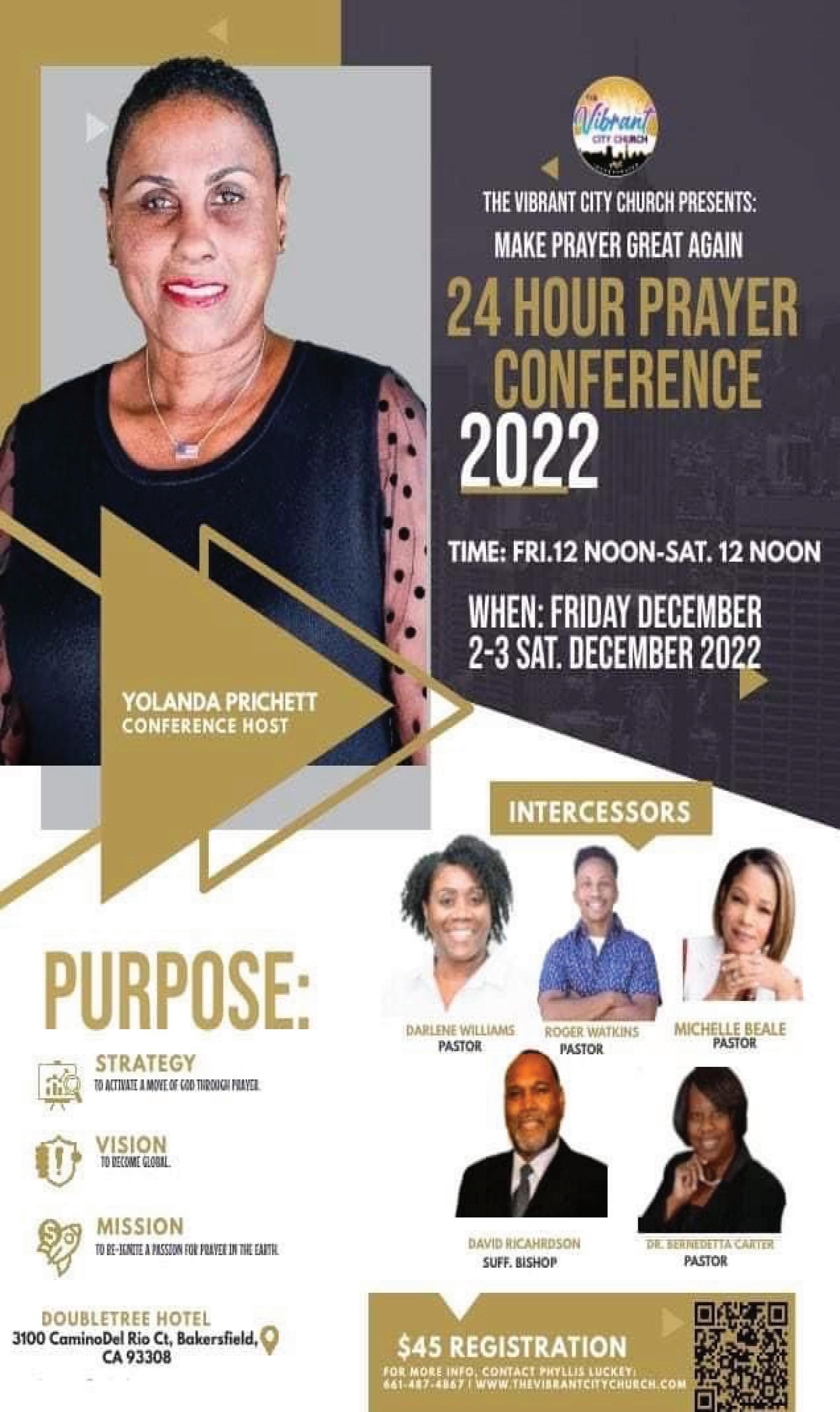
An infected person coughs or sneezes
You get virus droplets from a cough or sneeze in your eyes, nose, or mouth
You have direct contact with the virus, like kissing the face of a child with RSV
You touch a surface that has the virus on it, like a doorknob, and then touch your face before washing your hands
“People infected with RSV are usually contagious for three to eight days and may become contagious a day or two before they start showing signs of illness. However, some infants, and people with weakened immune systems, can continue to spread the virus even after they stop showing symptoms, for as long as 4 weeks. Children are often exposed to and infected with RSV outside the home, such as in school or childcare centers. They can then transmit the virus to other members of the family,” the CDC website stated.
People at the highest risk for severe disease include:
Premature infants
Young children with congenital (from birth) heart or chronic lung disease
Young children with compromised (weakened) immune systems due to a medical condition or medical treatment

Children with neuromuscular disorders
Adults with compromised immune systems
Older adults, especially those with underlying heart or lung disease
